Primordial Evolution Game/First Land: Difference between revisions
1d4chan>NO TRIP FOR THE HIVE No edit summary |
m (1 revision imported) |
(No difference)
| |
Revision as of 21:59, 18 June 2023

This page details the events of the second Primordial Evolution Game thread.
Progenitors
Frowg: It is an amphibious creature living in the moss swamps, which catch small worems by using small electrical shocks generated by its large front legs.
Wesck: an agile aerial creature which preys on worems. It has a tough hide which protects their float bladders, and a pair of wings which provide locomotion. It also has harpoon appendages that it uses to hunt, as well as a stinger at the end of their tail.
Glund: a herbivorous offshoot of the worem. It has armor plating, and can roll into a defensive ball. It also produces offspring by giving live birth.
Stalck: a sluck descendant which has adapted to a life of a land predator. Its armor protrusions have developed into full legs, and currently it hunts by ambush. Due to its coloration it's mostly nocturnal, and retreats to the humid moss patches during the day.
Flouz: Another amphibious-capable creature, the flouz is a rather slow creature possessing tough skin. It can survive being out of the water, but prefers the ocean. It can drag itself using two strong tentacles on the land, and it also has two phosphorescent patches to surprise prey or predator, as it is still a main staple of bladeworems.
Pluup: Another fus-derived creature, the pluup manages to survive in the humid moss patches, slowly devouring them. It has two strong tentacles to drag it around, and some protective tentacles housing stingers to deter predators.
Evola: The Evola is an aquatic plant which evolved from the moss. It has cup-shaped bladders, used to get more sunlight.
Yantar, which is the interconnected bushlike plant I mentioned the last thread. It is a descendant of the moss, and it has cuplike leaves that can gather rainwater.
Frowg

Purple Frowg

progenitor: Frowg
-> Electric Purple Frowg
The Frowg skeleton grew into a ridged spine of cartilage disks to protect its back from Wesck attacks. Their lungs developed to breathe the oxygen condensing in the atmosphere. They evolved prehensile tongues as a sensory organ in the pursuit of prey. The Frowg began to habitat the Poisonous Evola. Their pigment changed to match its host plant and they developed tougher hides, resilient to the toxins but without osmosis. They grew nimble claws which they used to pry curled glunds, and to groom their host Evola clean of other parasites. This created a well kept territory to house their broods.
Electric Purple Frowg
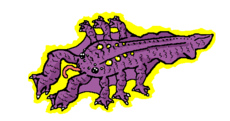
progenitor: Purple Frowg
-> None Known
The Frowg regained their latent bio-electric capabilities to fight against its predators. They emit electro-kinetic pulses that pack a small physical force. Clever Frowgs lured Stalcks into traps of disorienting electricity. They turned predators into prey, and from these fights survived the fittest. They grew streamlined scales and strong fins to start skimming the waters around their habit. They fed on a diet of Fus larvae, sea-Worems, and radiated berries. During a minor ice age, their metabolism slowed down. Because of their diet of radiated fruit, they developed energy storing organs on their backs. To further conserve energy they began hibernating between times of plenty of food.
Wesck Evolution

Wesck
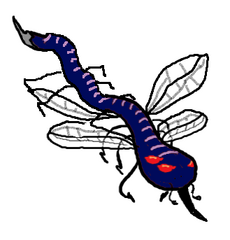
progenitor: Wesck
-> Night Wesck
The evolved from of the progenitor, these Wescks have adapted to increase their survival. They had a tough hide to protect their float bladders, a pair of wings, as well as harpoons and a tail stinger. They developed a proboscis to adopt a omnivore diet. Their body evolved a longer body and more legs while grounded. They grew an extra set of eyes due to increased radiation in the area.
Night Wesck
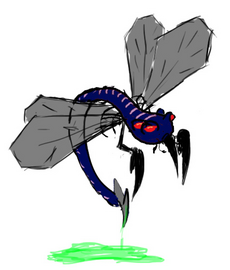
progenitor: Wesck
-> Day Wesck
These nocturnal Wesck are dark blue in color and hunt floating Flouz. A hardened chitin spike replaced the proboscis which they use to ram at the thin skin of their prey. They attack in swarms and share the kill. They changed their posture to curve their stringer tails. Their chitin spike also became curved. The swarm now used a pincher like attack with their tail and spike. When the climate changed, the swarm became more lethargic. To compensate, they developed a smelly sap from its tail. They layer the sap in prime hunting area during the warmer periods of the night. During the day, they cling to rocks using claw life forearms.
Day Wesck

progenitor: Night Wesck
-> None Known
During the climate change some nocturnal Wesck started hunting during the day and their color turned pale blue. Their wing size increased allowing blood vessels in them to warm their body, and requiring less energy for longer flights. They developed hooks to drag Flouz down, allowing more Wesck to catch and tear there hide. To handle threats to the swarm, they pick dangerous predators high up and drop them. They avoid Frrila isles, not able to handle their toxins, and will rarely land on them for the night. During the night the swarm forms a nest ball to keep warm. A strange mutation occurs to the oldest and strongest Wesck, and sometimes to Wesck in frequent contact with the Frrila. They lose their wings and become heavily armored. These guardians protect the nest ball during the night. A single Stack may kill them, but their death releases a pheromone that frenzies the rest of the swarm into attacking.
Flouz Evolution

Gas Flouz
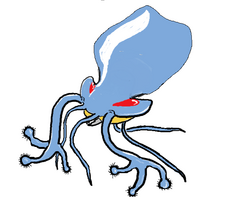
progenitor: Flouz
-> Winged Flouz
-> Chufluoz
-> Hopper Flouz
The Flouz tentacles developed terminals ending in three bubs, barbed hairs, and sucker cups. The tentacles grew longer allowing them to anchor itself, constrict prey, and drag itself across land easier. A branch of the Flouz began to use gas sacks to store lighter than air gases. Their gas sacks expand allowing them to float off the ground.
Chufluoz

progenitor: Gas Flouz
-> None Known
The majority of the Flouz limbs doubled, including its gas bladder, making it more resilient to Wesck swarms. Their primary tentacles developed into a trap organ. Barbed hairs are used to ensnare prey while the minor tentacles drag it to the mouth. They developed phosphorescent patches on its head to lure unwary fliers such as Flouz larvae. They developed vents to release gas for increase mobility, leading to increased opportunities for predation. Through consecutive breeding, they gain strong muscular tentacles and increased size, capable of deterring wesck swarms, or grabbing larger prey.
Winged Flouz

progenitor: Gas Flouz
-> None Known
In response to Wesck swarms, the Flouz developed gas propulsion to speed away. In their trail, they leave a slightly acidic gas to deter following predators. In response to Chambered Flouz out competing them, they adapted by taking small forms and growing wings from their rear wings. This more agile form moved them into another ecological niche. They developed longer wings and sharper peaks. The barbed hairs of its toes are replaced with sharp hooks. These fast flying creatures specialized in hunting other Flouz larvae.
Hoppa
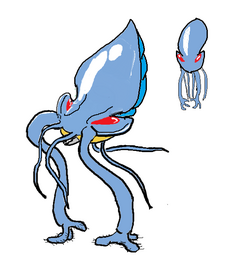
progenitor: Gas Flouz
-> Harpoon Flouz
-> Runner Flouz
-> Giant Flouz
Due to increased predation and climate change, Flouz gas sacks became reinforced with tougher plates. This increased mass forced them to the ground. In response, their main tentacles grew into strong legs, allowing them to "hop" around. Flouz produced hundreds of larvae that still float in the air, most never reach adulthood.
Boomer
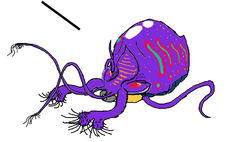
progenitor: Hopper Flouz
-> Flame Boomer
-> Eastern Boomer
A herbivore off-shoot of Hopper Flouz developed tougher skin to hold volatile gases caused by eating toxin plants. The gas sacks grew too large for their primary tentacles to stand on. They started to crawl slowly on the ground. To facilitate crawling they excrete a thick slime which also traps small creatures, giving the Boomer an easy meal.
Harpoon Flouz

progenitor: Hopper Flouz
-> Nomadic Flouz
To avoid predators, The Flouz developed strong legs with muscles and pseudo bones. This increased their running speed and forced their eyesight into the infrared. Their new legs were covered in hairy barbs that act as feelers and deter things grabbing them. To handle the toxic food, they developed a second stomach to properly metabolize them. Although the deadly poisons are quickly neutralized, residue slowly accumulates which shortens their lives. They increased their metabolism and became smaller. With this second stomach, the Flouz were able to raid Ground Glund nest for food. They communicated through pheromone glands to raid the Glund as a herd. The Flouz developed a herd mentality. Their tongues became long a sticky to fish out the Glund from under the Yantar. In response to the Glund Soldiers, their tongues evolved hard and barbed cartilage, and they lost their stickiness.
Nomadic Flouz

progenitor: Harpoon Flouz
-> None Known
Because of toxins slowly eating them alive and Glund nest becoming harder to raid, massive Harpoon Flouz herds disappear. Nomadic Flouz are smaller. They developed more socially complex societies. They traveled the land gathering and hunting for food. Their legs became stronger and sturdier. Their brains formed key brain structures. Lastly they started carrying their larvae inside them allowing them to develop further.
Giant Flouz

progenitor: Hopper Flouz
-> None Known
The Giant Hopper was a massive omnivore that prowled the undergrowth, and ate everything with their peaks. To support their increased mass, they developed larger gas sacks and sturdier legs. Instead of hopping they lazily mow down plants and animals. They have thick skin and two muscular whip tentacles.
Runner Flouz
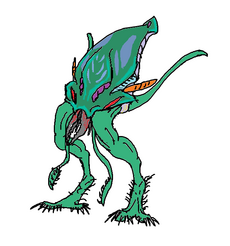
progenitor: Hopper Flouz
-> None Known
The Running Flouz is a predatory creature, that hunts other smaller creatures and ground bound flouz, such as the Harpoon Flouz and their descendants the Nomadic Flouz. Their barbed hairs developed into sharp hooks that give them a firm grip on the ground. Their forward facing tentacles also developed barbs to grab their prey. Their rear tentacles became tails giving them balance while running.
Stalck
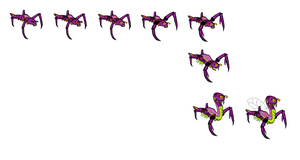
Stalck
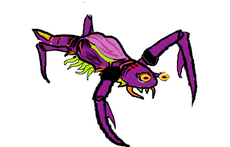
progenitor: Stalck
-> Flying Stalck
The Stalck evolved larger and more specialized eyes that have low light and mild infrared vision. Their front legs became more robust and developed pincers. Due to exposure to Poison Evola Toxins, the Stalck's intestines expanded and became powerful enough to metabolize Frowg enzymes. When a Frowg is eaten its toxin is converted and stored in the Stalck's back abdomen. Prey pinned down by their pinchers are injected with this kicked up toxin. This lead to a new behavior where Stalck raid Frowg colonies, and then continue hunting larger prey elsewhere.
Flying Stalck

progenitor: Stalck
-> None Known
Because of the capable Frowgs turning attacks against them, only the most aggressive and resilient survived. The next generation had bigger craniums and an expanded digestive track to produce more toxin. Any poison not converted is metabolized into energy. Due to a strange mutation, the Stalck grew wings which it uses against raiding Wesck and local Frowg.
Glund
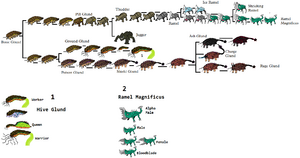
Glund

progenitor: Glund
-> Burrowing Glund
-> Poison Glund
The evolved form of the Glund. It gained a passive camouflage that mixed well with the moss and dirt. They also grew small spikes on their armored shell. This let them roll better as deter predators from biting them.
Ground Glund

progenitor: Glund
-> Nesting Glund
Due to the Pod Yantar's radiation, some Glund lost their legs and started burrowing underground. They used their powerful muscles to wriggle in the soil. Their gums developed into strong tentacles to shovel the soil. Their teeth developed into hooks with tubes to ingest roots and nutrients. After eating irradiated Yantar roots, they evolved special cells to harness the energy. Their stomachs brake down minerals with strong acids and the harnessed energy. In time their bodies grew longer improving the efficiency of their digestion, and leaving more minerals intact for their host plant. Females started digging birthing cambers near the Yantar's roots so that their young would harness enough energy in their own cells.
Nesting Ground Glund

progenitor: Ground Glund
-> None Known
The Glund evolved new nesting behaviors. They dug interconnected tunnels that branched away from their host plant, and created large birthing chambers beneath the plant. They feed from soil away from the Yantar. After many generations, the Ground Glund started to metabolize the Yontar toxin into energy or concentrated secretions. Many beneficial mutations divided the Glund population into different classes, such as: Queen, Solider, and Worker class. Females became larger and birthed more mature spawn. The Glund Queen sits in the birthing chamber and feeds on male Glund until death. The Queen will feed for three days and give birth to up to ten Glund. New Females feast on the old Queen and take her place. Soldiers protect the nest and workers abroad. The first Soldiers had hollow tendrils with mandibles to inject toxins or suck bodily fluids. Some Soldiers evolved different mouths, a combination of mandibles and spinnerets. These Soldiers create low-hanging webs with warning line that alert Solider pits. In response to invading Flouz tongues, the mandibles became serrated to cause more damage. Most Workers gather minerals and energy for the Queen. Some Workers evolved a suction cup mouth to consume slime. As a result their bodies bloat with toxin and energy. On the surface, they are slow and caught by predators. They eat the Bloated Glund and are poisoned. When Storms flooded the Yantar plants, some Bloat Glunds feed on the water. They combined water with slime to make glucose. Either deviation is fed to the Queen and Soldiers for their own energy needs.
Poison Glund
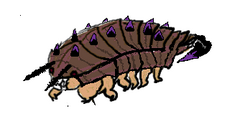
progenitor: Glund
-> Shield Glund
Due to their diet of Poison Evola, the Glund have gained a resistance to its poison. Their pigment changes and they start secreting the poison through their spikes. Their antennae grew longer and electrically sensitive. They used their new senses to locate Mevola. To eat the Mevola they anchored their tail running the plant's current to ground. During the minor ice age, the Glund grew bigger and thickened their carapace. Adult Glund grew serrated horns which they used to take down plants and opponents. They used their increased size and toughness to raid Ground Glund nests in times of scarcity. In time their antennae were replaced with distributed small hairs and forward eyes. Their anchoring tail grew a poisonous blub to inject via tail spike strikes.
Evola Evolution
Tall Evola

progenitor: Evola
-> Mevloa
The Evola developed a hard stalks to keep pests away and a complicated root system which they used to spread itself. From these roots they grew duplicate stalks. The Tall Evola started growing in marshlands as well as coasts. Their leaves grew larger due to more water nutrients. The Evloa started growing resin similar to Wesck pheromones. Wesck captured are dissolved for their nutrients.
Mevola

progenitor: Evola
-> None Known
Nutrients from soil, water, and digested wescks, gathered on the tip of the resin stalk. These minerals were highly conductive and lead to more lightning strikes in Melova marshlands. Their root system responded by consolidating and growing denser. These root Hubs stored electrical energy. To deter new threats, their spines sharpen and their leaves became like tentacles now, designed to ensnare these new threats. They discharged excess energy through the ends of their tendrils, to incapacitate prey.
Poison Evola
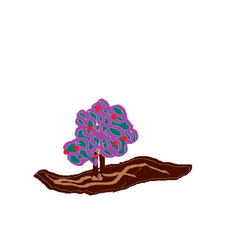
progenitor: Evola
-> Frilla
An off-shoot of the Evola slowly shifts colors and secretes an irritant for those species that eat Evola. They started to flourish in the coasts, due to decreased predation. Cross pollination on the coasts between Tall, and Poison Evola has created a strain with both a hard to digest stalk, and poisonous bulbs Due to the absorption of waste from the Frowgs. The Evola developed a series of stalks that trap water This keeps them fed by the excess nutrients brought in, and begins the formation of a symbiotic relations with the Frowgs. The Evola grew berries, which neutralize radiation to protect the plant and its inhabitants.
Frilla

progenitor: Poison Evola
-> None Known
Due to the stalks holding more weight, Evola bases ballooned out replacing the old root systems. They now float across the water off the coast. Each subsequent generation grew bigger to sustain Frowgs and Stalck populations. During the minor ice age, the Frilla developed electric static to keep its temperatures close to optimal. When the ice age passed, they stabilized themselves and spread across the oceans. They grew roots connecting separate nodes together, allowing the Frowg to travel out into the sea and back to the Frilla.
Yantar
Pod Yantar

progenitor: Yantar
-> Nest Yantar
The Yantar roots grew strong, deeper to reach water and resist winds. They found isolated muddy patches and thrived on them. The Yantar plant buds with purple flowers that spread spores. Toxins circulated the plant after finding poison, radioactive soil. The Yantar spores surround the atmosphere and spread radiation. The spores shut down respiratory systems. The dead bodies decompose and rot into the plant's soil bed. The roots get thicker to gain some ground in the moist soil as well as to take added nutrients from the dead.
Nest Yantar

progenitor: Pod Yantar
-> None Known
In response to burrowing Ground Glund, the Yantar developed thicker and more toxic roots to deter these new pests. Until they accepted the Glunds nesting chambers and the finer broken down soil. The Yantar and glund evolved together. The Yantar grew spongy moss on its roots which is harvested by the Glund. The moss is transported to farming chambers where mushrooms grow. The fungus feeds the Glund and fertilizes the Yantar. They grew deeper into the radioactive soil. The central frond became dominant. Calcium from the soil strengthened the leaves. Small spikes formed in the bowl of the central stock. The yontar plant evolved honey comb calcium over its leaves. This kept the plant strong against predators.